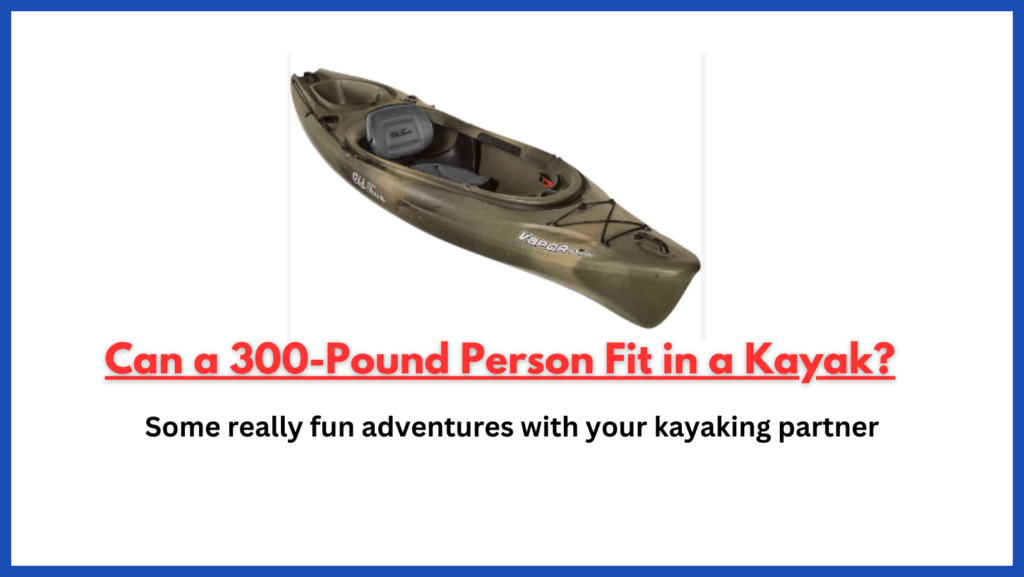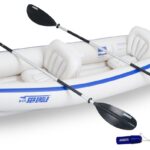Can a 300-Pound Person Fit in a Kayak?
Kayaking is a fantastic way to explore the outdoors, offering relaxation, adventure, and exercise. But for individuals who weigh around 300 pounds, the question arises: Can a 300-pound person fit in a kayak? The short answer is yes, but choosing the right kayak is crucial. In this comprehensive guide, we will cover kayak types, weight limits, stability factors, and recommendations for the best kayaks for heavier individuals.
Understanding Kayak Weight Limits
Kayaks are built with weight limits to ensure stability and performance. If you weigh 300 pounds, choosing a kayak with at least a 400-pound capacity is ideal. This extra capacity accounts for gear, water accumulation, and movement while paddling. Overloading a kayak can make it unstable and harder to maneuver. Sit-on-top kayaks generally have higher weight capacities than sit-in models. Wider kayaks also offer better buoyancy and balance. Always check the manufacturer’s specifications before purchasing.
Stability is a key factor when selecting a kayak for heavier paddlers. Wider hulls provide better support and reduce the risk of tipping. Many fishing and recreational kayaks are designed to accommodate larger paddlers. These models often feature reinforced hulls and extra-wide cockpits. Inflatable kayaks with high weight limits can also be a great option. They offer portability while maintaining strong weight support. Testing a kayak before buying can help determine comfort and balance.
Comfort is another important consideration when choosing a kayak. Look for models with adjustable seats and ample legroom. Padded seats with lumbar support can make long trips more enjoyable. Footrests should be adjustable to fit different leg lengths. Some kayaks come with elevated seating for better visibility and comfort. Sit-on-top kayaks allow for easier entry and exit, which is beneficial for larger paddlers. A stable and spacious design enhances the overall paddling experience.
Tracking and speed can be affected by weight distribution in a kayak. A well-balanced kayak with a strong keel helps maintain direction. Longer kayaks generally track better than shorter ones. However, extra weight can slow down performance. Paddlers should distribute gear evenly to avoid tilting. Some kayaks include skegs or rudders to improve navigation. Choosing a kayak with a higher weight limit ensures better speed and control.
Durability is crucial when selecting a high-weight-capacity kayak. Materials like high-density polyethylene (HDPE) provide excellent strength. Rotomolded kayaks are impact-resistant and built to last. Composite kayaks are lighter but may not handle rough impacts as well. Inflatable kayaks made from reinforced PVC can be surprisingly durable. Regular maintenance helps extend the lifespan of any kayak. Checking for wear and tear before each trip ensures safety and reliability.
Storage space is essential for carrying gear, especially on longer trips. Kayaks with larger weight capacities often include extra storage compartments. Dry storage hatches keep essentials safe from water exposure. Bungee cords and deck rigging provide additional gear storage. Fishing kayaks may feature built-in rod holders and tackle storage. Properly securing gear prevents weight imbalance and improves stability. Choosing a kayak with enough storage enhances convenience and safety.
Common Kayak Weight Capacities
- Recreational Kayaks: 250–350 pounds
- Touring Kayaks: 300–400 pounds
- Fishing Kayaks: 400–600 pounds
- Tandem Kayaks: 500–750 pounds
- Sit-on-Top Kayaks: 350–600 pounds
For a 300-pound individual, it is advisable to opt for a kayak with a weight capacity of at least 400 pounds to ensure stability and proper flotation.
Kayak Types Suitable for a 300-Pound Person
Not all kayaks are created equal. The type of kayak you choose determines your comfort and paddling experience.
1. Sit-on-Top Kayaks
Sit-on-top kayaks are an excellent option for heavier paddlers due to their open design and high weight capacities. They provide better weight distribution and are easy to enter and exit. Many fishing kayaks fall into this category, offering enhanced stability.
2. Sit-In Kayaks
Sit-in kayaks provide better protection from wind and water but have a more confined cockpit. While some touring kayaks can support a 300-pound paddler, choosing a wider model with a larger cockpit is advisable.
3. Inflatable Kayaks
Inflatable kayaks have become increasingly durable and capable of carrying heavier weights. Many models support up to 600 pounds, making them a viable choice for a 300-pound paddler.
4. Tandem Kayaks
Tandem kayaks, designed for two people, often have higher weight capacities. A solo paddler can use a tandem kayak for additional space and weight support.
Stability Factors for Heavier Paddlers
Stability is a critical factor when choosing a kayak for a 300-pound person. Here’s what affects a kayak’s stability:
1. Width
A wider kayak (at least 30 inches) provides better primary stability, reducing the likelihood of tipping over.
2. Hull Shape
Flat-bottom hulls offer more stability on calm waters, while pontoon-style hulls provide superior balance, especially for fishing or standing activities.
3. Weight Distribution
Distributing weight evenly prevents the kayak from leaning to one side. Some kayaks have reinforced seats and adjustable footrests to accommodate heavier paddlers.
4. Material and Build Quality
Rotomolded polyethylene kayaks are strong and durable. Composite materials like fiberglass and carbon fiber are lighter but may have lower weight capacities.
Best Kayaks for a 300-Pound Person
Here are some top recommendations for kayaks that comfortably support a 300-pound paddler:
1. Perception Pescador Pro 12
- Weight Capacity: 375 lbs
- Type: Sit-on-top
- Pros: Stable, comfortable seat, great for fishing
2. Wilderness Systems Tarpon 120
- Weight Capacity: 350 lbs
- Type: Sit-on-top
- Pros: Comfortable seating, excellent stability
3. Sea Eagle 380X Inflatable Kayak
- Weight Capacity: 750 lbs
- Type: Inflatable
- Pros: High weight limit, portable, durable
4. Old Town Sportsman PDL 120
- Weight Capacity: 500 lbs
- Type: Pedal kayak
- Pros: Hands-free pedaling, high weight capacity, excellent tracking
5. BKC TK122 Tandem Kayak
- Weight Capacity: 770 lbs
- Type: Tandem sit-on-top
- Pros: Versatile for solo or tandem use, very stable
Tips for a 300-Pound Paddler
- Choose a kayak with a high weight limit: Look for kayaks rated at least 400 pounds to allow for extra gear.
- Check seat comfort: Adjustable, well-padded seats provide better support.
- Use a stable paddle: A longer paddle with a strong grip helps maintain control.
- Practice balance: Get comfortable entering and exiting the kayak before heading into deep waters.
- Wear a properly fitted PFD (Personal Flotation Device): Ensure it supports your weight and allows freedom of movement.
Conclusion
A 300-pound person can absolutely fit in a kayak, provided they choose the right type. Stability, weight capacity, and comfort should be top priorities when selecting a kayak. Whether you prefer a sit-on-top, sit-in, inflatable, or tandem kayak, many models cater to heavier paddlers. By selecting a kayak with the right features and practicing safe paddling techniques, you can enjoy an amazing kayaking experience with confidence.



